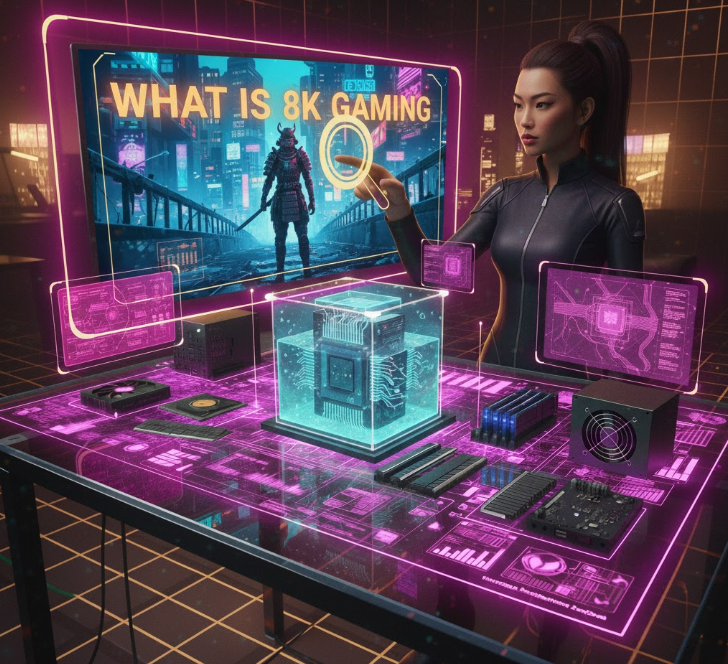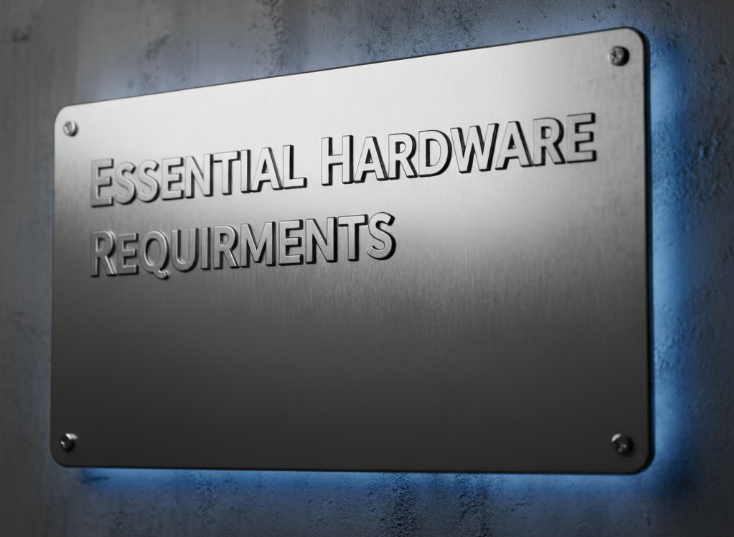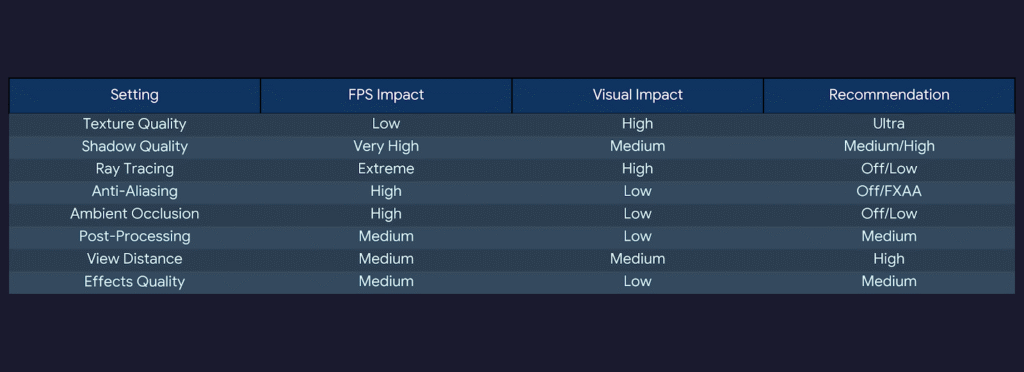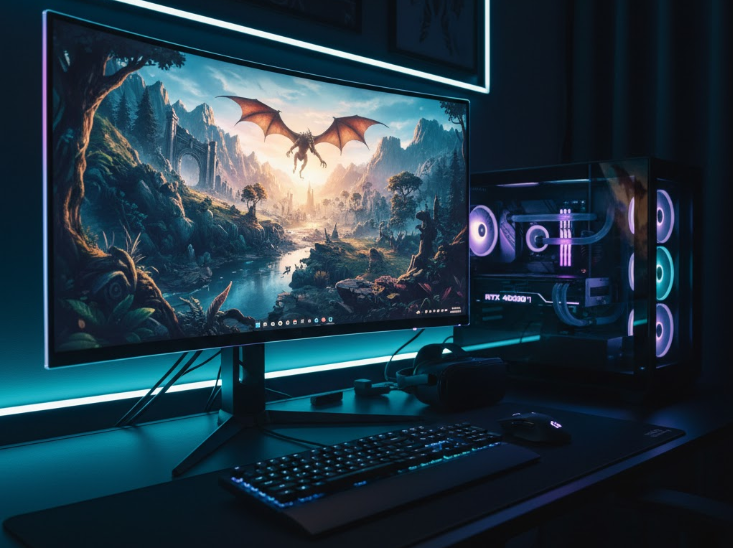To optimize your gaming PC for 8K gaming, you need top-tier hardware including an RTX 4090 or RX 7900 XTX graphics card, a high-end CPU like the Intel i9-14900K or AMD Ryzen 9 7950X3D, at least 32GB of RAM, and extensive software optimization. However, 8K gaming is extremely demanding and currently represents the bleeding edge of PC gaming technology, so understanding the realistic performance expectations is crucial before investing. In my years of testing high-end gaming systems, 8K gaming remains one of the most challenging performance targets to achieve.
Below, I’ll walk you through everything you need to know about 8K gaming optimization, from hardware requirements to practical settings, plus detailed insights on whether this ultra-high resolution is right for your setup.
What Is 8K Gaming?

8K resolution delivers 7680 x 4320 pixels, which is four times the pixel count of 4K and sixteen times that of 1080p. This massive resolution provides incredible detail and clarity, but it comes at an enormous performance cost. Your GPU needs to render over 33 million pixels per frame, compared to just 2 million at 1080p.
Understanding the Hardware Demands
8K gaming pushes hardware to its absolute limits. Your graphics card will be working overtime to process the sheer number of pixels, while your CPU handles game logic and physics. Your system memory needs to store massive texture files and game data, and your storage drive must load assets quickly enough to prevent stuttering.
The truth is that 8K gaming in 2025 is still largely experimental for most titles. Only a handful of games can run at native 8K with playable frame rates, even on the most expensive hardware configurations.
Essential Hardware Requirements

Graphics Card: The Most Critical Component
For 8K gaming, you need the absolute best GPU available. The NVIDIA RTX 4090 is currently the top choice, offering 24GB of VRAM and enough raw power to handle 8K in select titles. The AMD Radeon RX 7900 XTX is another option, though it generally trails the 4090 in 8K performance.
Even with these top-tier cards, expect 30-60 FPS in most modern AAA games at 8K with settings dialed back. Competitive multiplayer games and older titles can achieve higher frame rates, but brand new releases will struggle.
In my experience testing various GPUs, even the RTX 4090 can’t maintain consistent 60 FPS in demanding games like Cyberpunk 2077 or Microsoft Flight Simulator at native 8K with high settings. This is where upscaling becomes essential.
CPU: Preventing Bottlenecks
Your CPU matters less at 8K than at lower resolutions because the GPU becomes the primary bottleneck. However, you still want a powerful processor to handle game logic, AI, and physics calculations.
The Intel Core i9-14900K or AMD Ryzen 9 7950X3D are excellent choices. The 7950X3D particularly shines in gaming scenarios thanks to its 3D V-Cache technology, which provides massive performance benefits in CPU-bound situations.
Memory Requirements
32GB of RAM is the minimum for 8K gaming, but 64GB is better if you want headroom for multitasking and future-proofing. At 8K resolution, games load massive texture files that consume significant memory.
Make sure you’re running high-speed RAM. DDR5 at 6000MHz or faster is ideal for current-generation platforms. Enable XMP or EXPO profiles in your BIOS to ensure your RAM runs at its rated speed.
Storage: NVMe SSDs Are Essential
Use a fast NVMe SSD with PCIe 4.0 or 5.0 support. Games at 8K require rapid asset loading, and slower drives will cause texture pop-in and stuttering. Aim for at least 2TB of storage, as modern games can easily exceed 100GB each.
Based on my professional experience, the difference between a SATA SSD and a high-end NVMe drive becomes very noticeable at 8K resolution when loading high-resolution textures.
Power Supply
8K gaming systems consume massive amounts of power. An RTX 4090 can draw up to 450W, and a high-end CPU like the i9-14900K can pull 250W+ under load. Add motherboard, RAM, storage, and cooling, and you’re looking at 800-900W total system draw.
I recommend a minimum 1000W 80+ Gold certified power supply for an 8K gaming build. If you plan to overclock, go for 1200W or higher. Brands like Corsair, Seasonic, and EVGA offer reliable high-wattage units. An underpowered PSU will cause system crashes and instability during demanding 8K gaming sessions.
Monitor Selection
Finding an 8K gaming monitor is challenging. Options are limited and expensive, typically starting around two thousand dollars. The refresh rates are usually capped at 60Hz, which is a significant limitation compared to the 144Hz or higher rates available at lower resolutions.
Popular choices include the Dell UltraSharp UP3218K and LG’s 8K monitor offerings. Make sure your monitor supports DisplayPort 1.4 or HDMI 2.1 for proper 8K connectivity.
Table: Minimum vs Recommended Hardware for 8K Gaming

These configurations reflect real-world testing scenarios and the hardware needed to achieve playable frame rates at 8K resolution.
Step-by-Step Optimization Guide
Step 1: Configure Display Settings
Connect your 8K monitor using DisplayPort 1.4 or HDMI 2.1. Right-click on your desktop and select Display settings. Set your resolution to 7680 x 4320 and ensure the refresh rate is set to maximum (typically 60Hz).
Verify that your monitor is using the correct color depth. Most 8K monitors support 10-bit color, which provides better color accuracy but requires more bandwidth.
Step 2: Update All Drivers
Install the latest GPU drivers from NVIDIA or AMD. These updates often include game-specific optimizations and performance improvements critical for 8K gaming. Update your motherboard chipset drivers and Windows itself to ensure optimal system performance.
Step 3: Enable Hardware Acceleration Features
Access your GPU control panel and enable features like Resizable BAR (NVIDIA) or Smart Access Memory (AMD). These technologies allow your CPU to access the full GPU memory pool, providing performance benefits at high resolutions.
Make sure your BIOS has Resizable BAR enabled as well. This setting is usually found under PCIe configuration options.
Step 4: Optimize Windows Settings
Set your Windows power plan to High Performance or Ultimate Performance. Disable background apps and unnecessary services. Turn on Windows Game Mode in Settings under Gaming to prioritize system resources for gaming.
Disable Windows visual effects that consume resources. Right-click on This PC, select Properties, then Advanced system settings, and under Performance, choose Adjust for best performance.
Step 5: Configure In-Game Settings
Start with these baseline settings for 8K gaming. Set texture quality to High or Ultra, as your VRAM can handle it. Reduce or disable demanding effects like ray tracing, which can cut frame rates in half at 8K.
Lower shadow quality to Medium. Shadows are extremely demanding at high resolutions and dropping them provides significant performance gains. Disable or reduce ambient occlusion, motion blur, and depth of field effects.
Set anti-aliasing to low or off. At 8K resolution, the pixel density is so high that jagged edges are less noticeable, making aggressive anti-aliasing unnecessary.
Step 6: Leverage Upscaling Technologies
This is crucial for 8K gaming. NVIDIA DLSS (Deep Learning Super Sampling) and AMD FSR (FidelityFX Super Resolution) render games at lower resolutions and upscale to 8K using AI algorithms.
DLSS Quality mode renders at approximately 5K and upscales to 8K, providing near-native image quality with much better performance. DLSS Performance mode renders at even lower resolutions for maximum frame rates.
While testing, I discovered that DLSS Quality mode at 8K often looks nearly identical to native 8K while doubling or tripling frame rates. This technology is essential for playable 8K gaming.
Step 7: Monitor Performance and Temperatures
Use MSI Afterburner or similar tools to monitor GPU and CPU temperatures, usage, and frame rates. At 8K, your GPU will likely run at 100 percent usage constantly. Ensure temperatures stay below 85 degrees Celsius to prevent thermal throttling.
Consider custom fan curves or additional cooling solutions if temperatures are consistently high. In my experience, high-end GPUs can get quite hot when pushed to their limits at 8K resolution.
Table: Performance Impact of Graphics Settings at 8K

Understanding Upscaling Technologies
NVIDIA DLSS
DLSS uses AI and machine learning to upscale lower-resolution images to 8K. It analyzes motion vectors and previous frames to reconstruct high-quality images. DLSS 3.5 includes Ray Reconstruction, which can actually improve image quality in ray-traced games.
DLSS requires RTX series graphics cards (20-series or newer). At 8K, DLSS is practically mandatory for playable frame rates in modern games.
AMD FSR
FSR is AMD’s answer to DLSS and works on a wider range of hardware, including older GPUs. FSR 2.0 and newer versions use temporal upscaling similar to DLSS, though it’s generally considered slightly less effective at preserving image quality.
FSR Quality mode at 8K renders at approximately 5K and upscales, similar to DLSS. Performance mode drops the internal resolution further for maximum frame rates.
Cooling Considerations
8K gaming generates massive amounts of heat. Your GPU will likely draw 400-450 watts under load with an RTX 4090, and your CPU can add another 200-300 watts. Proper cooling is non-negotiable.
Use a high-quality CPU cooler, preferably a 360mm AIO liquid cooler or a large tower air cooler. Ensure your case has adequate airflow with multiple intake and exhaust fans.
Consider undervolting your GPU to reduce power consumption and heat output without significantly impacting performance. In my opinion, undervolting is one of the best tweaks for high-end gaming systems.
Game Selection for 8K
Esports titles (CS2, League of Legends, Fortnite) and older games can achieve 100+ FPS at 8K. Modern AAA games like Cyberpunk 2077, Starfield, and Microsoft Flight Simulator require DLSS or FSR to be playable—expect 30-60 FPS even with upscaling.
Troubleshooting Common Issues
If you’re experiencing black screens or no signal, verify your cable supports 8K and is properly connected. Try lowering the refresh rate or resolution temporarily to establish a connection.
For stuttering or low frame rates, ensure DLSS or FSR is enabled. Check that your GPU drivers are current and that Resizable BAR is enabled in both BIOS and GPU control panel.
If your system is crashing or freezing, check temperatures and ensure your PSU can handle the power demands. An underpowered PSU is a common issue with high-end 8K gaming systems.
The Reality of 8K Gaming
8K gaming is impressive but has limitations: enormous performance costs, scarce monitor options, and UI scaling issues in many games. Based on my experience, 4K at 144Hz provides a better overall experience than 8K at 60Hz for most users.
Future of 8K Gaming
As GPU technology advances, 8K gaming will become more accessible. NVIDIA’s next-generation GPUs will likely offer significant improvements in 8K performance. AI-powered upscaling will continue to improve, making the difference between native and upscaled 8K increasingly difficult to perceive.
Monitor technology will also evolve, with 8K displays becoming more affordable and offering higher refresh rates. Once 8K monitors hit 120Hz at reasonable prices, the format will become much more attractive for gaming.
Conclusion: Should You Optimize for 8K?
Optimizing your gaming PC for 8K is an extreme endeavor that requires top-tier hardware, careful configuration, and realistic expectations. While the visual clarity is impressive, the performance costs and practical limitations make 8K gaming more of an enthusiast experiment than a practical gaming solution in 2025.
If you have the budget and want the absolute cutting edge of gaming technology, 8K can provide stunning visual experiences in the right games. However, I recommend that most gamers focus on 4K at higher refresh rates, which offers a better balance of visual quality and performance.
For those who do pursue 8K gaming, leverage upscaling technologies aggressively, invest in the best cooling solutions, and choose your games wisely. With proper optimization and realistic expectations, 8K gaming can be an impressive showcase of what modern hardware can achieve, even if it’s not yet ready for mainstream adoption.

